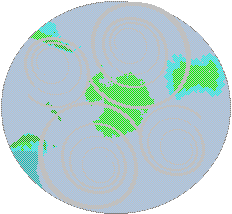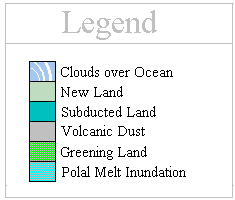
| |
 |
![]()


If the eruption of a single volcano can darken the atmosphere over the entire globe, a simultaneous and prolonged eruption of thousands of volcanoes would blacken the sky. Volcanoes vomit water vapor as well as cinders. Following the cataclysm, the author of Codex Chimalpopoca, in his history of the suns, shows us terrifying celestial phenomena .. followed by darkness that covered the face of the earth, in one instance for a period of 25 years.
In the Ermitage Papyrus in Leningrad .. there are lamantations about a terrible catastrophe, when heaven and earth turned upside down. After this catastrophe darkness covered the earth. The "shadow of death" is related to the time of the wandering in the desert after the Exodus from Egypt. The sinister meaning of the words "shadow of death" corresponds with the description of the Ermitage Papyrus: "None can live when the sun is veiled by clouds."
The phenomenon of gloom enduring for years impressed itself on the memory of the Twelve Tribes and is mentioned in many passages in the Bible. Psalms 44:19 - "The people that walked in darkness .. in the land of the shadow of death."
After a Pole Shift the former poles invariably melt and soften while the new poles take on layer after layer of ice and snow. This pace is not matched, as polar cap building only stabilizes at a point where evaporation and melting at glacial edges equals the arrival of newly fallen snow after some centuries. In the meantime the waters rise worldwide, several hundred feet, and then recede again. This pace is gradual, so that coastal settlements have plenty of time to relocate, an exercise they find they must do repeatedly.
In what way did this veil of gloom dissolve itself? Has any testimony been preserved that during the many years of gloom carbohydrate precipitated? After the nightly cooling, the carbohydrates precipitated and fell with the morning dew. It had an oily taste like honeycomb, and was ground between stones and baked in pans. The clouds brought the heavenly bread, it is also said in the Talmud.
There was a world fire, says the Icelandic tradition, followed by the Fimbul-winter, and only one human pair remained alive in the north. They fed on morning dew, and from (this pair) come the folk who people the renewed earth.
The Maoris of New Zealand tell of fiery winds and fierce clouds that lashed the waters into tidal waves that touched the sky and were accompanied by furious hailstorms. The ocean fled. The progeny of the storm and hail were "Mist, the Heavy dew and Light dew".
The Greeks called the heavenly bread ambrosia. It is described by the Greek poets in identical terms with manna: it had the taste of honey and a fragrance. The Atharva-Veda hymns say that honey-lash came down from fire and wind; ambrosia fell, and streams of honey flowed upon the earth. The grains also fell upon the water, and the rivers became milky in appearance (i.e. lands of milk and honey).